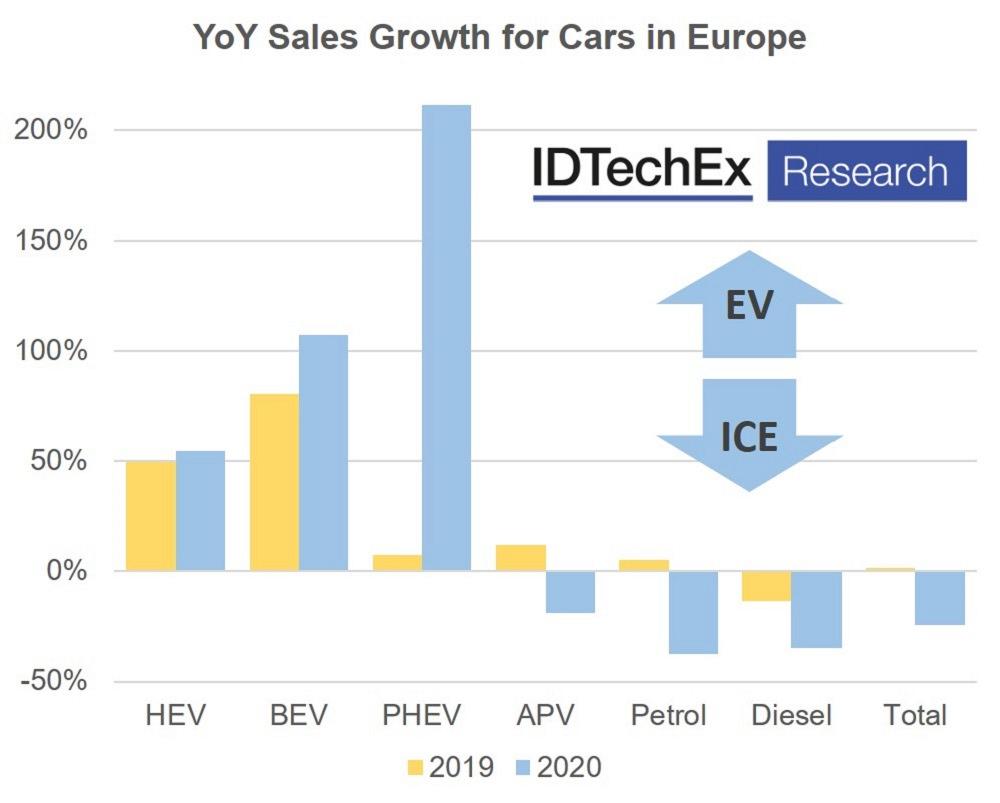- FMA
- The Fabricator
- FABTECH
- Canadian Metalworking
Categories
- Additive Manufacturing
- Aluminum Welding
- Arc Welding
- Assembly and Joining
- Automation and Robotics
- Bending and Forming
- Consumables
- Cutting and Weld Prep
- Electric Vehicles
- En Español
- Finishing
- Hydroforming
- Laser Cutting
- Laser Welding
- Machining
- Manufacturing Software
- Materials Handling
- Metals/Materials
- Oxyfuel Cutting
- Plasma Cutting
- Power Tools
- Punching and Other Holemaking
- Roll Forming
- Safety
- Sawing
- Shearing
- Shop Management
- Testing and Measuring
- Tube and Pipe Fabrication
- Tube and Pipe Production
- Waterjet Cutting
Industry Directory
Webcasts
Podcasts
FAB 40
Advertise
Subscribe
Account Login
Search
IDTechEx report reveals how electric vehicles have prospered despite pandemic
- April 22, 2021
- News Release
- Electric Vehicles
COVID-19 has had a drastic effect on the automotive industry, with factory shutdowns, fewer people commuting to work, and a resulting drop in car sales. But in the midst of these challenges, sales of high-voltage hybrids (HEVs), plug-in hybrids (PHEVs), and battery-electric vehicles (BEVs) increased in most regions worldwide, according to the IDTechEx report, “Electric Vehicles: Land, Sea and Air 2021-2041.”
In Europe, for example, sales of petrol, diesel, and other alternatively powered vehicles declined significantly in 2020, but HEVs were up 54%, BEVs up 107%, and PHEVs were up 211%.
HEVs currently are the drivetrain of choice for Japanese automakers such as Toyota and Nissan, with very strong sales for these companies across Japan and Europe. Despite only a moderate fuel consumption and emissions reduction, the HEV market for the next decade is promising, says IDTechEx, especially in the EU, before post-2030 fossil fuel bans start to hamper the market.
PHEVs, which are designed to help automakers to meet their emissions targets, are somewhat controversial in this regard because the real-world values can differ significantly from the ratings on the WLTP cycle. IDTechEx believes that PHEVs will not continue to be looked upon favorably when it comes to emissions, and under revision of current driving cycles, they will become far less beneficial for automakers and their emissions targets.
BEVs continue to gain market share, and big automakers that have been slow or reluctant to adopt BEVs are making big investments and transitions toward electrification. There still are challenges to widespread BEV adoption, including range anxiety, charging infrastructure, and cost, but these concerns are starting to fade, and IDTechEx expects BEVs to be the dominant form of transport in the long run.
subscribe now

The Fabricator is North America's leading magazine for the metal forming and fabricating industry. The magazine delivers the news, technical articles, and case histories that enable fabricators to do their jobs more efficiently. The Fabricator has served the industry since 1970.
start your free subscription- Stay connected from anywhere

Easily access valuable industry resources now with full access to the digital edition of The Fabricator.

Easily access valuable industry resources now with full access to the digital edition of The Welder.

Easily access valuable industry resources now with full access to the digital edition of The Tube and Pipe Journal.
- Podcasting
- Podcast:
- The Fabricator Podcast
- Published:
- 04/16/2024
- Running Time:
- 63:29
In this episode of The Fabricator Podcast, Caleb Chamberlain, co-founder and CEO of OSH Cut, discusses his company’s...
- Trending Articles
AI, machine learning, and the future of metal fabrication

Employee ownership: The best way to ensure engagement

Steel industry reacts to Nucor’s new weekly published HRC price

Dynamic Metal blossoms with each passing year

Metal fabrication management: A guide for new supervisors

- Industry Events
16th Annual Safety Conference
- April 30 - May 1, 2024
- Elgin,
Pipe and Tube Conference
- May 21 - 22, 2024
- Omaha, NE
World-Class Roll Forming Workshop
- June 5 - 6, 2024
- Louisville, KY
Advanced Laser Application Workshop
- June 25 - 27, 2024
- Novi, MI


























